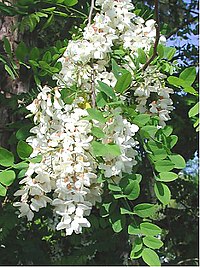
Photo from wikipedia
Simple Summary Obolodiplosis robiniae is an invasive species found across Eurasia. This species has now established itself as a common pest of black locust trees, with widespread infestations resulting in… Click to show full abstract
Simple Summary Obolodiplosis robiniae is an invasive species found across Eurasia. This species has now established itself as a common pest of black locust trees, with widespread infestations resulting in severe defoliation and substantial ecological and economic damage. Considering its biology and ecology, we applied a machine-learning algorithm based on the maximum entropy principle. The model’s predictions are consistent with the known distribution of O. robiniae. The total potential suitable area is 10,896,309.16 km2. In the context of future climate warming, the suitable area will extend to high latitudes, whereas the area in the south will decrease slightly. Governments should be concerned about the potential spread of O. robiniae throughout Eurasia, and quarantine measures should be implemented as soon as possible to avoid astronomical maintenance costs later on. Abstract Obolodiplosis robiniae was discovered in Eurasia at the beginning of the 21st century. In this study, we explore the present and future (in the years 2050 and 2070) trends in the potential distribution of O. robiniae in Eurasia under diverse climate change scenarios based on a maximum entropy model. Our findings indicated that the current potential distribution area of O. robiniae is within the range of 21°34′ and 65°39′ N in the Eurasian continent. The primary factor controlling the distribution of O. robiniae is temperature. The highly and moderately suitable areas are mainly distributed in the semi-humid and semi-arid regions, which also happen to be the locations where the host black locust (Robinia pseudoacacia L.) grows at its fastest rate. The forecast of the potential distribution area of O. robiniae revealed that the species would benefit from global warming. The region suitable for the habitat of O. robiniae is characterized by a large-scale northward expansion trend and an increase in temperature. This information would help the forestry quarantine departments of Asian and European countries provide early warnings on the probable distribution areas of O. robiniae and provide a scientific basis for the prevention and control of O. robiniae spread and outbreaks.
Journal Title: Insects
Year Published: 2023
Link to full text (if available)
Share on Social Media: Sign Up to like & get
recommendations!